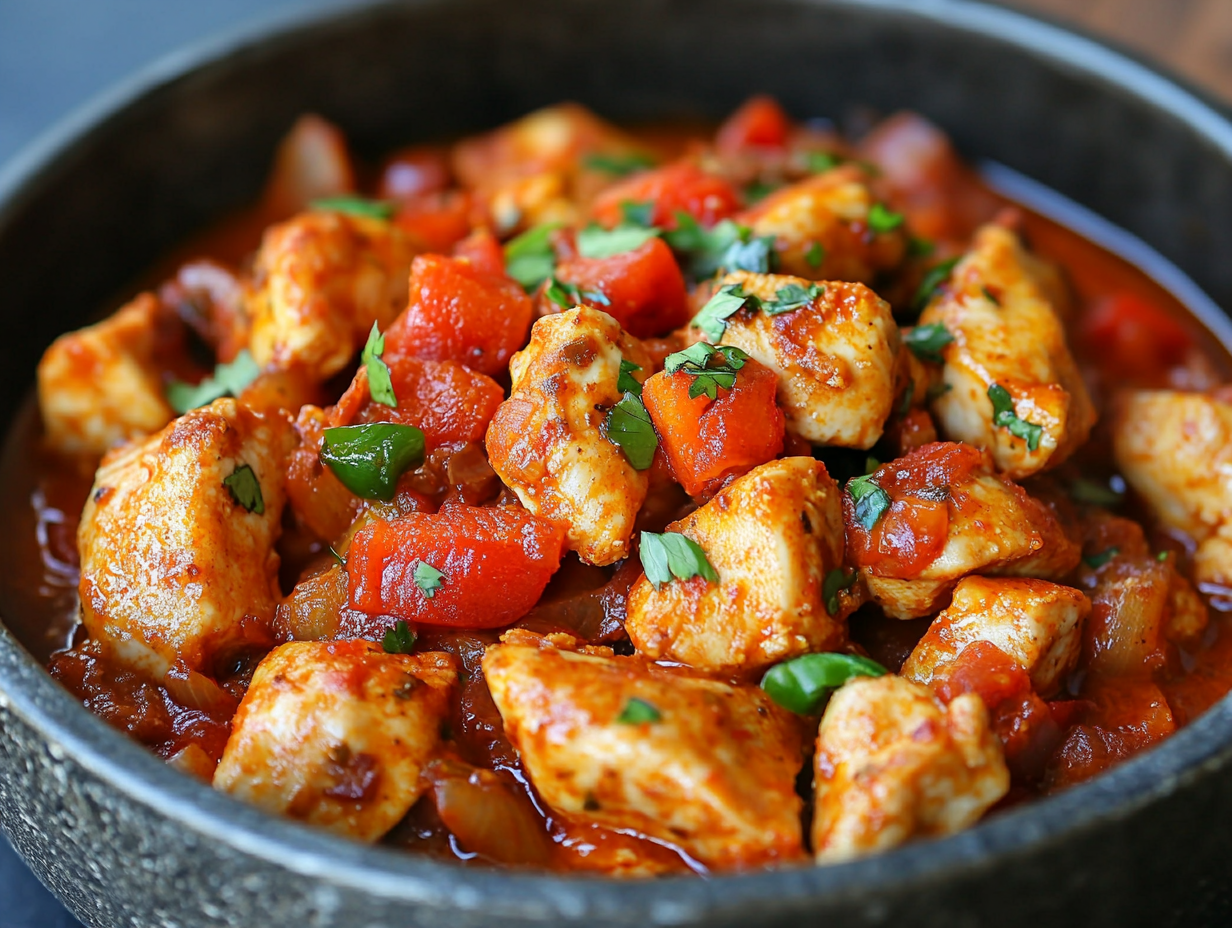Introduction to Chicken Piquant
Chicken Piquant is a tangy, spicy, and flavorful dish known for its bold seasoning and rich tomato-based sauce. The term “piquant” means “sharp” or “spicy,” and this dish perfectly balances tanginess from vinegar or mustard with a subtle heat from peppers and spices.
Originating from French and Cajun cuisines, Chicken Piquant has variations across cultures, each adding a unique twist. The best part? You can make this dish in under 30 minutes with minimal effort!
Ingredients for Quick and Easy Chicken Piquant
To keep it simple yet delicious, here’s what you’ll need:
- Chicken: Boneless skinless thighs or breasts for quick cooking
- Tomatoes: Crushed or diced for a rich base
- Vinegar: Apple cider or white vinegar for tanginess
- Mustard: Dijon or whole grain for extra depth
- Garlic & Onions: Essential aromatics
- Spices: Paprika, cayenne, salt, and black pepper
- Peppers: Bell peppers or chili peppers for heat
- Olive Oil: For sautéing
- Broth or Water: To adjust the sauce consistency
Step-by-Step Instructions to Make Chicken Piquant
- Sear the Chicken: Heat oil in a pan, season the chicken, and brown it for 3-4 minutes per side.
- Sauté Aromatics: Remove chicken and cook onions, garlic, and peppers until soft.
- Make the Sauce: Add tomatoes, vinegar, mustard, and spices, stirring well.
- Simmer: Return the chicken to the pan and let it cook for 10-15 minutes until tender.
- Serve Hot: Garnish with fresh herbs and enjoy!
The Secret to the Perfect Piquant Sauce
A great piquant sauce is all about balance. Here’s how to perfect it:
- Tangy Element: Vinegar or mustard provides acidity.
- Heat Level: Adjust cayenne or chili peppers based on your preference.
- Sweetness: A touch of honey or sugar balances the sharp flavors.
Best Cooking Methods for Chicken Piquant
- Stovetop: The quickest and most traditional method.
- Instant Pot: Pressure cook for 10 minutes for an effortless meal.
- Slow Cooker: Cook on low for 4-6 hours for deeper flavor.
Pairing Suggestions: What to Serve with Chicken Piquant
- Rice: Jasmine or brown rice soaks up the sauce well.
- Pasta: Egg noodles or linguine for a hearty meal.
- Mashed Potatoes: Creamy mashed potatoes balance the tangy sauce.
- Crusty Bread: Perfect for dipping!
Customizing Chicken Piquant to Your Taste
- Make it Creamy: Add a splash of heavy cream.
- Go Low-Carb: Serve over cauliflower rice or zucchini noodles.
- Extra Veggies: Mushrooms, zucchini, or spinach work well.
Health Benefits of Chicken Piquant
- High in Protein: Lean chicken supports muscle growth.
- Rich in Antioxidants: Tomatoes and peppers provide essential nutrients.
- Low-Carb Friendly: Skip the sugar and serve with veggies!
Common Mistakes to Avoid
- Overcooking Chicken: Leads to dry texture—use thighs for juicier results.
- Sauce Too Watery: Simmer longer to thicken.
- Too Much Spice: Start with less and add more if needed.
Storing & Reheating Chicken Piquant
- Fridge: Store in an airtight container for up to 4 days.
- Freezer: Freeze for up to 3 months.
- Reheat: Warm in a pan with a splash of broth to retain moisture.
Quick Hacks to Save Time When Cooking
- Use pre-cut veggies to skip chopping.
- Make the sauce ahead of time for a faster meal.
- Cook in a single pan for easy cleanup.
Variations of Chicken Piquant
- Cajun-Style: Add Creole seasoning and hot sauce.
- Creamy Version: Stir in heavy cream or coconut milk.
- Mediterranean Twist: Use olives, capers, and feta cheese.
The History and Influence of Piquant Dishes
Chicken Piquant has roots in French and Cajun cooking, blending acidic, spicy, and umami-rich flavors for a uniquely satisfying meal. Variations exist worldwide, from Italy’s chicken puttanesca to Mexico’s pollo en escabeche.
Frequently Asked Questions (FAQs)
1. Can I Use Chicken Breasts Instead of Thighs?
Yes, but thighs are juicier and more forgiving.
2. What Can I Substitute for Vinegar?
Lemon juice or white wine works well.
3. How Can I Make It Less Spicy?
Reduce or omit cayenne and chili peppers.
4. Can I Make This in Advance?
Yes! It tastes even better the next day.
5. What’s the Best Type of Mustard to Use?
Dijon adds the best flavor, but yellow mustard works too.
6. Can I Use Bone-In Chicken?
Yes, but cooking time will be longer.

